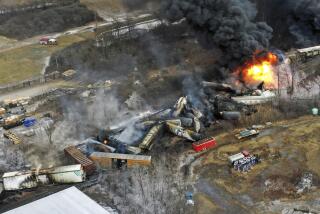Board Urges Shoulder Belts in Car Rear Seats : Calls for Mandatory Use After Study Shows Lap Restraints Can Cause Serious Harm in Crashes
WASHINGTON — The National Transportation Safety Board recommended Monday that the government require shoulder safety belts in the rear seats of all new cars after a study of 26 automobile crashes showed that lap belts can cause serious, even fatal, injuries.
The recommendation was included in a report that reviewed the accidents--all of them head-on collisions except one--and concluded that rear-seat passengers wearing only lap belts “may not be adequately protected against injury and may sustain additional injuries induced by the seat belt itself.”
The National Highway Traffic Safety Administration, which issues federal vehicle safety standards, quickly issued a statement disputing the safety board report. It said that its own data involving thousands of cases shows clearly that a rear-seat passenger “has a better chance of avoiding serious injury or death by wearing a lap belt as opposed to wearing no belt at all.”
The highway safety agency challenged the board’s findings as “the result of a specific search for cases in which belts failed.” It added that it would make an extensive analysis of the board’s study over the next few weeks and disclose its findings.
The National Highway Traffic Safety Administration is an agency of the Department of Transportation. The National Transportation Safety Board is an independent federal agency that investigates the causes of major transportation accidents.
The board’s report urged the highway safety administration to take immediate steps to make shoulder belts mandatory in rear seats, as they are in front seats. In the interim, the board said that auto manufacturers should voluntarily include rear-seat belts in all new models and offer better kits to install them in existing cars.
Patricia A. Goldman, acting safety board chairman, cautioned, however, that the report’s findings represented a small sample of mostly front-end crashes and did not evaluate the overall effectiveness of lap belts in all types of accidents.
“We don’t know whether it is best for rear-seat passengers to ride with only a lap belt or without one,” she said.
What the safety board does know, she said, is that all motorists are better protected when they are wearing shoulder belts.
When asked what advice she would offer those with rear-seat lap belts, she said: “Unfortunately that’s a choice consumers will have to make.” California is one of three states--Massachusetts and Washington are the others--that require rear-seat passengers to wear seat belts, according to the Highway Users Federation here.
Car Makers Plan Belts
Some auto makers have current plans for rear-seat shoulder belts.
General Motors spokesman John J. Hartnett said his company has announced plans to install rear-seat shoulder belts in some 1987-model cars and in all new cars by 1989. A Ford spokesman said rear-seat shoulder belts were offered with the 1986 Mercury Merkur and will become standard equipment in all Ford cars in the next few years. A number of foreign manufacturers already offer rear-seat shoulder belts.
In its investigation of 26 crashes--part of a larger overall study on seat-belt performance--the safety board said that “the crash performance of the lap belts in these cases was very poor,” resulting in injuries to the abdomen, spine or head from the “violent jackknifing” of the body upon impact.
The report said that of the 50 people who wore only a lap belt, 32 would have “fared substantially better” if they had worn shoulder belts.
“In many cases, the lap belts induced severe to fatal injuries that probably would not have occurred if the lap belts had not been worn,” the report said.
Killed Wearing Belt
In one accident, a 22-year-old woman driving a 1977 Chevrolet Chevette ran off the road and hit a tree. The driver was not wearing a seat belt and suffered serious injuries. Two children in the rear seat wore lap belts. One suffered minor injuries while the other was killed.
In another crash, a 1982 Subaru station wagon collided head-on with a 1979 Oldsmobile. The two adults in the front seat of the Subaru wore shoulder belts and suffered moderate injuries. Two children in the rear seat wore lap belts; the 4-year-old was seriously injured while the 5-year-old died as a result of injuries. The driver of the Oldsmobile, who did not wear a seat belt, was seriously injured.
“Wearing them is still better than not wearing them,” said Don Reed, Washington representative for the American Seatbelt Council.






